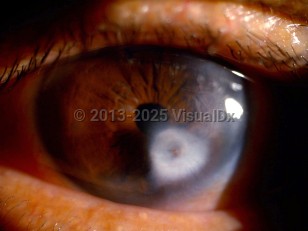Peters anomaly - External and Internal Eye
Alerts and Notices
Important News & Links
Synopsis

Peters anomaly is a congenital ocular condition with variable features of anterior segment dysgenesis. The essential clinical signs are a central or paracentral corneal scar (leukoma) with iris adhesions to the posterior surface (Type I). Occasionally the lens is adherent to the same area and contains some opacification (cataract) as well (Type II). These malformations are nonprogressive and are present unilaterally as an isolated finding, although they can be bilateral. The Peters-plus syndrome has both bilateral findings of Peters anomaly as well as systemic manifestations. The condition in most cases seems to be inherited in an autosomal recessive pattern as the result of mutations in a number of regulatory homeobox genes. Since these are primarily active during embryogenesis of ocular structures, it is not uncommon to find some features of Peters anomaly in other ocular conditions.
Peters anomaly is of clinical importance not only for its potential impact on vision, but because it is frequently associated with congenital glaucoma, for which early diagnosis and treatment is essential to the preservation of vision.
Peters anomaly is of clinical importance not only for its potential impact on vision, but because it is frequently associated with congenital glaucoma, for which early diagnosis and treatment is essential to the preservation of vision.
Codes
ICD10CM:
Q13.4 – Other congenital corneal malformations
SNOMEDCT:
204153003 – Irido-corneo-trabecular dysgenesis
Q13.4 – Other congenital corneal malformations
SNOMEDCT:
204153003 – Irido-corneo-trabecular dysgenesis
Look For
Subscription Required
Diagnostic Pearls
Subscription Required
Differential Diagnosis & Pitfalls

To perform a comparison, select diagnoses from the classic differential
Subscription Required
Best Tests
Subscription Required
Management Pearls
Subscription Required
Therapy
Subscription Required
References
Subscription Required
Last Updated:01/20/2022
Peters anomaly - External and Internal Eye

